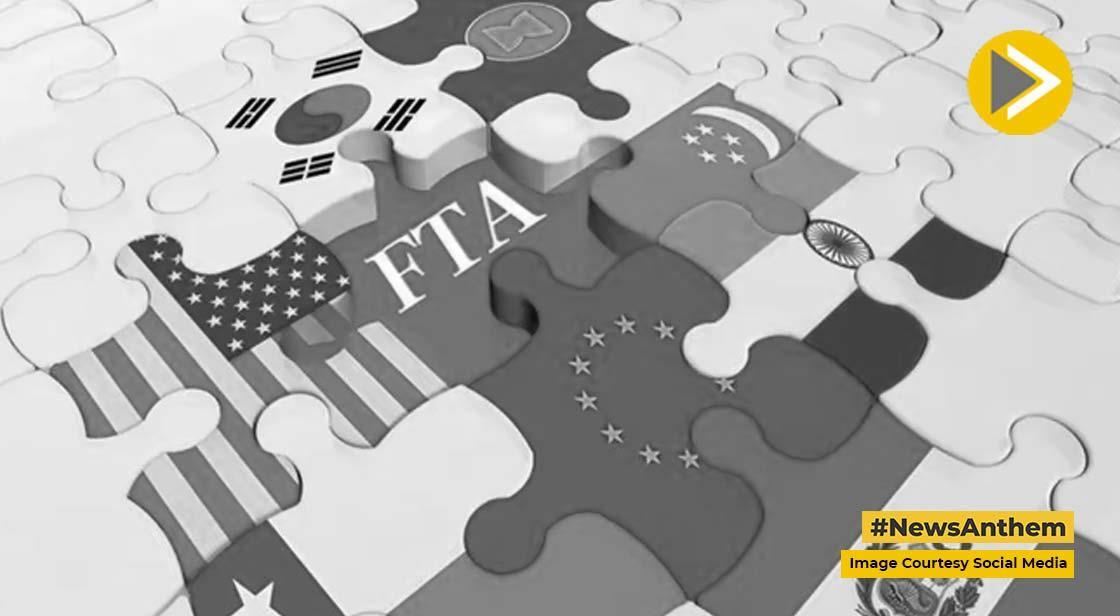India, EU Push Through Final Stretch of Free Trade Deal Negotiations

News Synopsis
India and the European Union are reportedly in the “last and the most arduous leg” of their Free Trade Agreement (FTA) negotiations, according to India’s commerce ministry. The two sides recently concluded the 14th round of talks held in Brussels, but several Indian negotiators remained in Brussels to continue discussions, particularly over rules of origin (ROO) provisions.
Commerce Secretary Rajesh Agrawal met with Sabine Weyand, the Director General (Trade) of the European Commission, to assess progress made during the latest round of negotiations.
What Are Rules of Origin (ROO) & Why They Matter
ROO defines the minimal threshold of processing for a product within a country to label it as made in that country.
Agrawal stated that the negotiating teams will engage in two-week continuous sessions aiming to achieve substantial progress, even as both India and the European Union push to finalize the FTA within 2025.
Virtual engagements are also underway even though the schedule for the next round hasn’t yet been finalized. Agrawal noted that India expects a physical visit from the EU trade delegation in November, adding that overall, “talks are progressing well” in light of gains from earlier rounds.
Stakes & Trade Interests
India aims to use the FTA to boost exports of labour-intensive goods to the EU, while the EU is pushing for greater access to the Indian market for automobiles and liquor.
Last month, India’s Commerce & Industry Minister Piyush Goyal stated that over 65 % of chapters in the FTA had been finalized during the 13th round of negotiations. Previously, sources in New Delhi had indicated that decisions on several remaining areas might require political direction from ministers on both sides.
During the 12th round of talks in Brussels, both sides exchanged offers in the services sector, tackling key areas of market access for goods as well.
In June 2025, Indian government sources said extra negotiation sessions had already been added, increasing the frequency from quarterly to monthly.
Media reports (CNBC-TV18) have suggested that India and the EU might consider an “early harvest deal” — a partial agreement on tariff and non-tariff barriers, intellectual property rights, government procurement, technical barriers to trade, and sanitary & phytosanitary rules — ahead of finalizing the full FTA.
The broader strategy includes a two-stage approach, along with a bilateral investment protection agreement and recognition of geographical indications (GIs) with the 27-member EU bloc.
Historical Context & Negotiation Resumption
The trade discussions between India and the EU originally began in 2007, covering trade in goods, services, investment, standards, dispute settlement, intellectual property rights, GIs, and sustainable development — among other areas. The talks stalled in 2013 and remained dormant until mid 2022 when negotiations were revived.
Economic & Trade Statistics
India’s goods trade with the EU in 2024-25 stood at USD 136.53 billion, composed of exports of USD 75.85 billion and imports of USD 60.68 billion. This makes the EU India’s largest partner in goods trade.
The EU accounts for roughly 17 % of India’s total exports, while India represents about 9 % of the EU’s total external shipments.
In services, bilateral trade between India and the EU was estimated at USD 51.45 billion in 2023.
Negotiations now span 23 chapters covering areas such as goods, services, investment, SPS (sanitary and phytosanitary), technical barriers, trade remedies, ROO, customs and trade facilitation, government procurement, competition, dispute settlement, intellectual property rights, geographical indications, sustainable development, and more.
Challenges & Key Issues
-
Automobile and Liquor Duties: The EU is pushing for tariff cuts on cars and alcoholic beverages; India is cautious given domestic sensitivities.
-
Sensitive Sectors: India is wary of liberalizing sectors such as dairy, rice, and agriculture too deeply, where it maintains protection.
-
Political Decisions: Several unresolved chapters may require ministerial or political level decisions — making this phase truly the “last leg.”
-
Standards & Regulation: Harmonizing stringent EU standards (SPS, technical regulations) with Indian industry capacity remains challenging.
-
Investment Protection & GIs: Parallel negotiations for investment treaty and recognition of geographical indications (GIs) must align with trade outcomes.
Outlook & Timeline
India and the EU have set 2025 as the target year for concluding the FTA. With momentum high, accelerated negotiation rounds and possible early harvest agreements are being considered to lock in gains while resolving tougher chapters. The increased frequency of meetings and use of virtual as well as in-person engagement signal both sides’ urgency.
According to analysis, geopolitical alignment and strategic priorities may help overcome obstacles. If successful, the FTA would significantly reshape bilateral trade by facilitating lower tariffs, greater market access, and stronger regulatory coherence.
Conclusion
India and the EU are now in the crucial final stretch of their Free Trade Agreement negotiations, navigating some of the toughest unresolved issues such as rules of origin, market access, standards, and investment protection. With both sides aiming to finalize the deal by 2025, the current negotiation phase demands intensive, sustained engagement at technical and political levels.
If successfully concluded, the FTA promises to deepen economic integration, increase India’s export competitiveness, and reshape Indo-EU trade ties. However, the balance between ambition and safeguarding sensitive domestic interests will determine whether this “most arduous leg” ends in success or compromise.
You May Like









